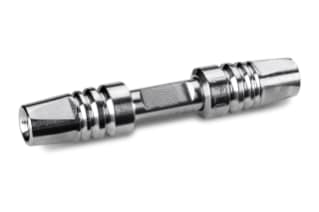
|
Chemistry |
Pepsin |
|
Separation Mode |
Protein Digestion |
|
Particle Substrate |
Silica |
|
pH Range Min |
1 pH |
|
pH Range Max |
8 pH |
|
Endcapped |
No |
|
Silanol Activity |
Low |
|
Particle Shape |
Spherical |
|
Particle Size |
5 µm |
|
Endfitting Type |
Direct-Connect |
|
Pore Size |
300 Å |
|
QC Tested |
Protein |
|
Format |
Column |
|
Surface Area |
185 |
|
System |
HPLC |
|
Inner Diameter |
2.1 mm |
|
Length |
30 mm |
|
UNSPSC |
41115709 |
|
Application |
Protein |
|
Brand |
Enzymate |
|
Product Type |
Columns |
|
Units per Package |
1 pk |


FAQs about Enzymate Pepsin Column
For which specific applications is the Enzymate Pepsin Column designed?
The Enzymate Pepsin Column is designed for the on-column digestion of proteins into peptides, facilitating downstream peptide mapping and protein sequencing applications.
How does the immobilized pepsin in the Enzymate Pepsin Column enhance digestion efficiency?
The immobilized pepsin in the Enzymate Pepsin Column offers high enzymatic activity while being retained on the column, allowing proteins to be digested efficiently as they pass through, which streamlines the workflow by combining digestion and separation steps.
Can the Enzymate Pepsin Column be reused for multiple digestions, and if so, how many times?
The Enzymate Pepsin Column is designed for multiple uses, but the exact number of reuses will depend on the sample matrix and the rigorousness of the cleaning protocol. Users should follow the manufacturer’s guidelines for specific reuse information.
What are the optimal operating conditions for the Enzymate Pepsin Column to maintain enzymatic activity?
The optimal operating conditions for the Enzymate Pepsin Column involve maintaining an acidic pH where pepsin is active, typically around pH 2, and following recommended temperature settings to ensure enzymatic efficiency.
Is the Enzymate Pepsin Column compatible with high-performance liquid chromatography (HPLC) systems?
Yes, the Enzymate Pepsin Column is designed to be compatible with HPLC systems, allowing for the seamless integration of enzymatic digestion into the HPLC workflow for protein analysis.
What Is The Purpose Of Protein Analysis?
The purpose of the protein assay is to determine the amount or concentration of a specific protein or an array of different proteins in a sample.